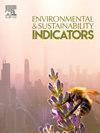Balancing ecosystem services for environmental sustainability: An integrated assessment method in region 4 of Iran's spatial plan
IF 5.4
Q1 ENVIRONMENTAL SCIENCES
引用次数: 0
Abstract
Human activities and overpopulation have disrupted the balance of ecosystem services (ESs), leading to environmental instability. This study introduces an integrated assessment method for assessing ecosystem functions by identifying ecological functional zones based on supply-demand ratios for key services, including water yield, soil retention, food production, and carbon storage. Additionally, we assess regional carrying capacity using these ratios. By integrating land suitability with carrying capacity, we identified areas suitable for agricultural, urban, and industrial development within Region 4 of Iran's spatial plan. The findings reveal considerable spatial variability, with over 90 % of the region experiencing water yield deficits. Notably, strong synergies exist among carbon storage, soil retention, and water yield, with statistically significant explanation coefficients of 0.85 and 0.61, respectively (p < 0.01). Based on ecosystem functionality, we classified the landscape into four zones: reconstruction (61 %), restoration (21 %), protection (6 %), and developable areas (12 %). The 6 % protection zone primarily within the Central Zagros—a critical water-supplying region—encompasses forested and mountainous areas such as Lordegan, Koohrang, and parts of Farsan, Izeh, Andika, and Borujen counties. These counties exhibit high water yield and carbon storage with minimal soil erosion. We recommend designating this zone as a protected area and implementing integrated watershed management strategies to enhance environmental sustainability. Alarmingly, only 0.2 % of the region is deemed suitable for future agricultural, industrial, and urban development, underscores the urgent need to prevent excessive agricultural expansion in Khuzestan and Isfahan provinces to protect regional sustainability. This approach highlights the necessity of integrating ecosystem science into spatial planning to support—an adaptable framework, for other Middle Eastern regions facing similar environmental challenges.

平衡生态系统服务促进环境可持续性:伊朗空间规划第4区综合评估方法
人类活动和人口过剩破坏了生态系统服务平衡,导致环境不稳定。本研究提出了一种综合评价生态系统功能的方法,该方法基于关键服务(包括水量、土壤保持、粮食生产和碳储存)的供需比来确定生态功能区。此外,我们使用这些比率评估区域承载能力。通过整合土地适宜性和承载能力,我们在伊朗空间规划的第4区域内确定了适合农业、城市和工业发展的区域。研究结果揭示了相当大的空间差异,超过90%的地区经历了水量不足。值得注意的是,碳储量、土壤保有量和水量之间存在较强的协同效应,解释系数分别为0.85和0.61 (p <;0.01)。基于生态系统功能,我们将景观划分为四个区域:重建区(61%)、恢复区(21%)、保护区(6%)和可发展区(12%)。6%的保护区主要位于中部扎格罗斯——一个关键的供水地区——包括森林和山区,如洛德根、库朗,以及法尔桑、伊泽、安蒂卡和博鲁仁县的部分地区。这些县具有较高的水量和碳储量,土壤侵蚀最小。我们建议将该地区指定为保护区,并实施综合流域管理战略,以提高环境的可持续性。令人担忧的是,该地区只有0.2%的土地被认为适合未来的农业、工业和城市发展,这突显了在胡齐斯坦省和伊斯法罕省防止农业过度扩张以保护区域可持续性的迫切需要。这种方法强调了将生态系统科学纳入空间规划的必要性,以支持其他面临类似环境挑战的中东地区的适应性框架。
本文章由计算机程序翻译,如有差异,请以英文原文为准。
求助全文
约1分钟内获得全文
求助全文
来源期刊

Environmental and Sustainability Indicators
Environmental Science-Environmental Science (miscellaneous)
CiteScore
7.80
自引率
2.30%
发文量
49
审稿时长
57 days
 求助内容:
求助内容: 应助结果提醒方式:
应助结果提醒方式:


